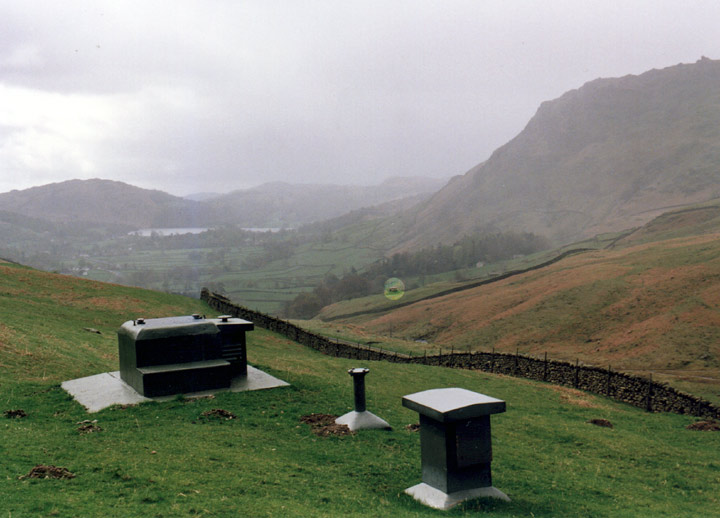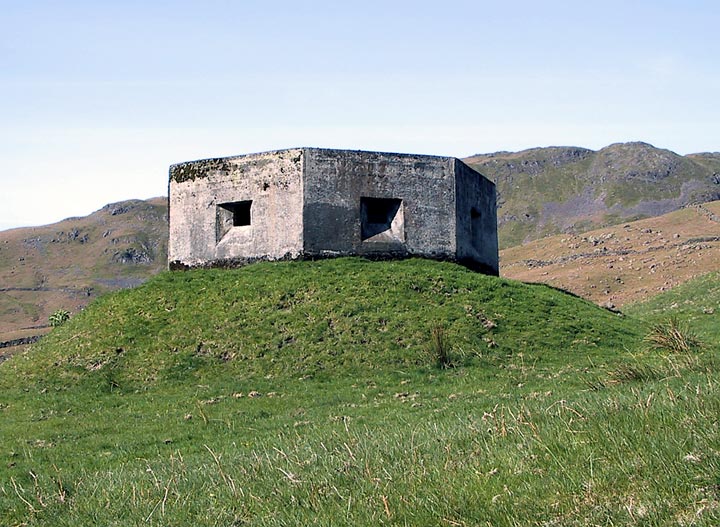
This ancient boundary between the old counties of Cumberland and Westmorland last saw battle in AD945, when the Norse King Dunmail lost out to the Anglo-Saxon King Edmund of Northumbria. It is said by some that the pile of stones at the top of the raise marks Dunmail's grave, while others believe he fled Eastwards and died in Rome, years later. However, I digress.....!
Pictured below is the ROC underground monitoring post (Grasmere) taken on a typical Cumbrian day; - wet.... The lighter spot marks the position of the WWII pill-box.

These odd-looking pipes and lumps stuck incongruously onto the fell-side above Dunmail Raise betray the fact that fifteen feet below the steel trap-door in the squat, concrete, cube-like protrusion, three observers would - if necessary - have eaten, drunk, breathed, slept and worked - possibly for up to one long week - mewed up in their subterranean post, a meagre fifteen feet long by seven foot six inches wide, monitoring radioactive fallout from a thermonuclear explosion, should such a terrible and dreadful thing ever have happened.
This ominous but vitally necessary role was reflected in the other 1,563 Royal Observer Corps UKWMO posts dotted strategically around the UK. The rural populace surrounding this picturesque part of lakeland may well have been warned of the onset of armageddon by the undulating wail of a hand-cranked siren signalling an air-attack. Three loud bangs, generated by a 'maroon' (sound flare) fired from the post would have followed soon afterwards, warning all survivors of the inevitable and deadly nuclear fallout...
This post near Grasmere, just tens of yards behind the listed AA telephone kiosk at the summit of Dunmail Raise, was opened in December 1964, and closed in September 1991, when the cold war had thawed for the last time and the Berlin Wall had fallen; the Soviet axis and its ideologies a threat no more.
Regarding the photograph: From the left of the structure and rearwards is the entrance hatch. Fifteen feet deep with a small 'Elsan' chemical toilet in a cubicle at the bottom of the shaft, a wooden door offering some privacy. A hand-operated bilge-pump on the wall next to the ladder allowed water seepage to be ejected from the shelter's sump below (rubber mats were often added by the crew, to stave off the bone-numbing chill).
To the right of the hatch is a set of louvred air-vents, upon which would be mounted the 'Ground-Zero' indicator - a canister containing sensitised paper, which would record any thermonuclear fireball through holes aligned to the cardinal compass points.
The large protruding pipe with the flange attached was for fitment of an ionisation chamber, connected to a survey probe beneath to measure radioactive fallout. To the right of this pipe was a smaller pipe (not visible here) which had a Bomb-Power Indicating sensor, the blast operating a meter below.
The box-like capped structure in the foreground is another louvred air-vent, emanating above the two bunk-beds within. Down inside, between the bunk-beds and the entrance was a small cupboard, and a table with 'teletalk' apparatus allowing communication with the outside world. A 'carrier broadcast' system allowed receipt of attack warning status, with the whole lot illuminated by a 12-Volt battery-operated lamp mounted above.
This post - which would have cost somewhere in the region of £1,250 to construct - has, like many others, now been demolished; not a trace remains.
A pill-box type FW3/24 stands quite isolated, and is readily spotted on the western side of Dunmail Raise. Strategically placed on the main A591, it covers the road (which would have been narrower during the war) both ways.

Home | Contents | Workington | Links | E-Mail